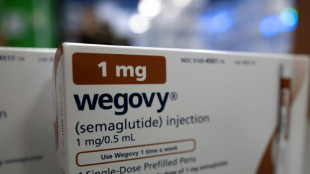

The winding, fitful path to weight loss drug Ozempic
Half a century of advancements in biomedical science paved the way for today's powerful weight-loss drugs like Ozempic -- so what was that journey like for the scientists involved?
Joel Habener of Massachusetts General Hospital and Svetlana Mojsov of The Rockefeller University, who are being honored with the prestigious Lasker Award for their role in the research, spoke to AFP about how they made the discoveries that changed the way we think about weight.
The pair will share the award -- often considered a predictor of future Nobel success -- as well as an honorarium of $250,000 with Lotte Bjerre Knudsen of Novo Nordisk, which manufactures Ozempic.
- Early molecular biology -
Obesity has escalated into a global health crisis, affecting 900 million people worldwide -- including over 40 percent of Americans and nearly a quarter of Europeans.
But back in the mid-1970s, when Habener, now 87, began his career as a physician-scientist, his curiosity was focused on diabetes.
He was particularly interested in the pancreatic hormone glucagon, known for raising blood sugar levels -- the opposite effect of insulin, which was already used as a treatment for diabetes.
By understanding and potentially modulating glucagon's effects, Habener believed he could uncover new ways to manage diabetes.
To pursue this, he turned to the emerging field of molecular biology, aiming to isolate and clone the gene that encodes glucagon.
- Fortuitous turn to fish -
But he quickly hit a roadblock: the US National Institutes of Health had just banned the type of research he planned to conduct on mammalian genes.
This pushed him to pivot to studying the anglerfish, a creature with a unique endocrine organ outside the pancreas.
"It turned out to be a godsend in terms of simplicity," he recalled, describing the eureka moment when he isolated a precursor protein that gave rise to glucagon -- as well as a second hormone that resembled glucagon.
Though Habener didn't realize its significance at the time, this turned out to be the fish-equivalent of "GLP-1," the foundation for today's diabetes and obesity drugs.
"That's what's beautiful about discovery research," he said. "By exploring the unknown, you get surprises."
- Identifying GLP-1's potential -
Mojsov, who emigrated from Yugoslavia, took the early discoveries made by Habener and others further with several important contributions.
Poring over the hormone's structure, she correctly predicted the active form of GLP-1 and devised innovative chemistry methods to synthesize it.
She also proposed that GLP-1 would be released in the intestines and act to trigger insulin production. Together with Habener and others, she proved this theory through lab experiments and human trials, identifying its therapeutic potential.
"I was sure it would be a good drug for diabetes," said the 76-year-old. However, at the time, there was no scientific evidence that hormones could regulate weight.
It was only later studies by Habener, Mojsov, and others that revealed GLP-1's ability to slow stomach emptying and its interaction with receptors in the brain, helping to curb appetite and possibly even address substance addictions.
- New era of treatments -
Starting in the 1990s, Knudsen, the head of GLP-1 therapeutics at Novo Nordisk, and her team built on these breakthroughs to develop treatments for diabetes (Ozempic) and obesity (Wegovy), extending the drug's therapeutic effects from just a few hours to over a week.
"Now we can see that GLP-1 actually has a much broader spectrum of health benefits," said Mojsov, though she laughs off the "miracle drug" label.
Obese patients "lose a lot of weight but also their muscle mass, and that's also very serious," she stressed. "I think it should never be taken for cosmetic reasons."
GLP-1 drugs have now been approved for treating cardiovascular disease, and emerging evidence suggests they may offer protective effects against dementia.
Though the exact mechanism remains unclear, Habener suggests their ability to suppress inflammatory pathways might be the common link.
As for the future, Mojsov is optimistic. She foresees a new generation of similar drugs that will further minimize side effects and target an even broader range of diseases.
A.Loughty--MC-UK




